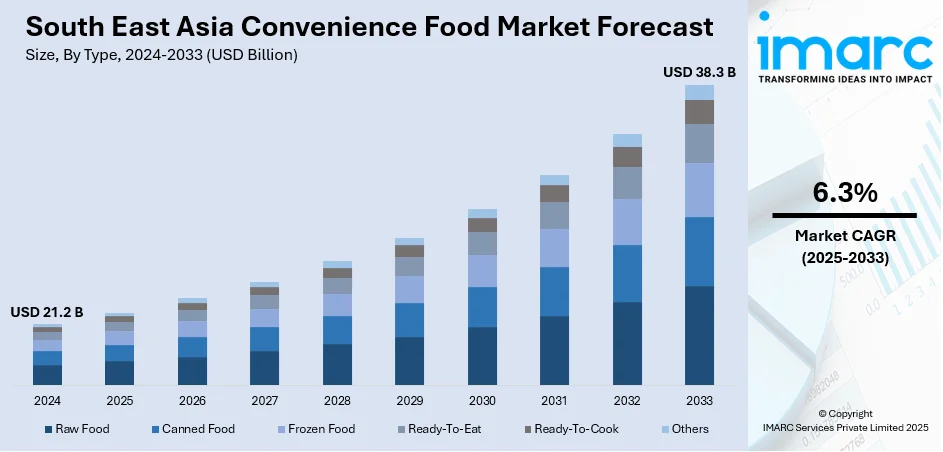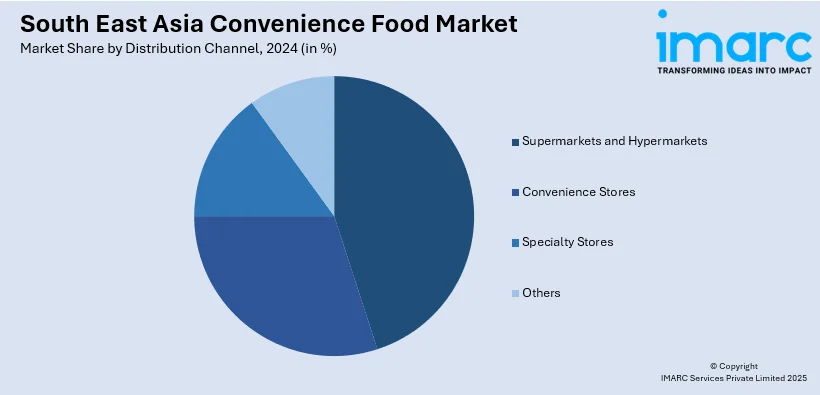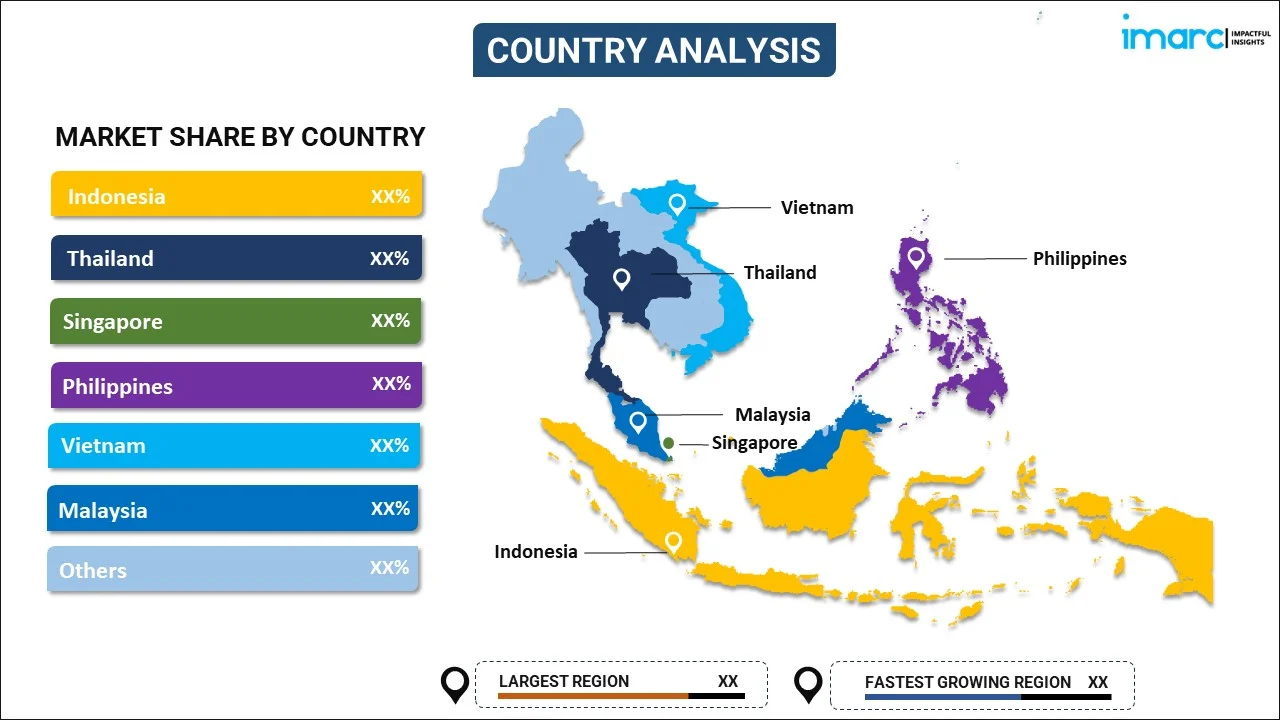
South East Asia Convenience Food Market Report by Type (Raw Food, Canned Food, Frozen Food, Ready-To-Eat, Ready-To-Cook, and Others), Product (Meat/Poultry Products, Cereal-based Products, Vegetable-based Products, and Others), Distribution Channel (Supermarkets and Hypermarkets, Convenience Stores, Specialty Stores, and Others), and Country 2025-2033
Market Overview:
South East Asia convenience food market size reached USD 21.2 Billion in 2024. Looking forward, IMARC Group expects the market to reach USD 38.3 Billion by 2033, exhibiting a growth rate (CAGR) of 6.3% during 2025-2033. The rising popularity of quick and accessible meal solutions, owing to fast-paced lifestyles of individuals, along with the introduction of enhanced food delivery services, is primarily driving the regional market.
|
Report Attribute
|
Key Statistics
|
|---|---|
|
Base Year
|
2024
|
|
Forecast Years
|
2025-2033
|
|
Historical Years
|
2019-2024
|
| Market Size in 2024 | USD 21.2 Billion |
| Market Forecast in 2033 | USD 38.3 Billion |
| Market Growth Rate 2025-2033 | 6.3% |
Convenience food refers to food products that are pre-packaged or processed, designed for quick and easy preparation with minimal time and effort. These food items cater to individuals with busy schedules, limited culinary skills, or a preference for immediate consumption. Within the category of convenience foods, there is a diverse range, including ready-to-eat meals, frozen dinners, canned soups, instant noodles, microwaveable snacks, and pre-cut vegetables. To extend shelf life and preserve quality, these foods typically undergo processing such as cooking, freezing, drying, and packaging. While convenience foods offer the benefit of saving time and simplifying meal preparation, they come with certain trade-offs. To enhance flavor and prolong preservation, these foods may contain increased levels of preservatives, additives, sodium, and sugar. These additives are employed to maintain the taste and quality of the products but may contribute to nutritional concerns.

To get more information on this market, Request Sample
South East Asia Convenience Food Market Trends:
The South East Asia convenience food market has emerged as a dynamic and influential sector, reflecting the region's rapid urbanization, changing lifestyles, and a rising demand for easily accessible meal solutions. Comprising countries such as Indonesia, Malaysia, Thailand, Vietnam, and the Philippines, this market has experienced significant growth, driven by a combination of economic factors and evolving consumer preferences. Additionally, the bustling urban centers in South East Asia have witnessed an increase in the number of individuals with hectic schedules, limited time for meal preparation, and a preference for on-the-go options. Besides this, the South East Asia convenience food market is characterized by a variety of locally produced and international brands, offering an extensive range of products to meet the diverse culinary needs of the population. While convenience foods provide a time-saving solution for busy individuals, there is an ongoing awareness of the nutritional trade-offs associated with these products. Moreover, as the region continues to experience economic growth and urbanization, the South East Asia convenience food market is poised for sustained expansion in the coming years.
South East Asia Convenience Food Market Segmentation:
IMARC Group provides an analysis of the key trends in each segment of the market, along with forecasts at the regional and country levels for 2025-2033. Our report has categorized the market based on type, product, and distribution channel.
Type Insights:
- Raw Food
- Canned Food
- Frozen Food
- Ready-To-Eat
- Ready-To-Cook
- Others
The report has provided a detailed breakup and analysis of the market based on the type. This includes raw food, canned food, frozen food, ready-to-eat, ready-to-cook, and others.
Product Insights:
- Meat/Poultry Products
- Cereal-based Products
- Vegetable-based Products
- Others
A detailed breakup and analysis of the market based on the product have also been provided in the report. This includes meat/poultry products, cereal-based products, vegetable-based products, and others.
Distribution Channel Insights:

- Supermarkets and Hypermarkets
- Convenience Stores
- Specialty Stores
- Others
The report has provided a detailed breakup and analysis of the market based on the distribution channel. This includes supermarkets and hypermarkets, convenience stores, specialty stores, and others.
Country Insights:

- Indonesia
- Thailand
- Singapore
- Philippines
- Vietnam
- Malaysia
- Others
The report has also provided a comprehensive analysis of all the major regional markets, which include Indonesia, Thailand, Singapore, Philippines, Vietnam, Malaysia, and Others.
Competitive Landscape:
The market research report has also provided a comprehensive analysis of the competitive landscape in the market. Competitive analysis such as market structure, key player positioning, top winning strategies, competitive dashboard, and company evaluation quadrant has been covered in the report. Also, detailed profiles of all major companies have been provided.
South East Asia Convenience Food Market Report Coverage:
| Report Features | Details |
|---|---|
| Base Year of the Analysis | 2024 |
| Historical Period | 2019-2024 |
| Forecast Period | 2025-2033 |
| Units | Billion USD |
| Scope of the Report | Exploration of Historical and Forecast Trends, Industry Catalysts and Challenges, Segment-Wise Historical and Predictive Market Assessment:
|
| Types Covered | Raw Food, Canned Food, Frozen Food, Ready-To-Eat, Ready-To-Cook, Others |
| Products Covered | Meat/Poultry Products, Cereal-based Products, Vegetable-based Products, Others |
| Distribution Channels Covered | Supermarkets and Hypermarkets, Convenience Stores, Specialty Stores, Others |
| Countries Covered | Indonesia, Thailand, Singapore, Philippines, Vietnam, Malaysia, Others |
| Customization Scope | 10% Free Customization |
| Post-Sale Analyst Support | 10-12 Weeks |
| Delivery Format | PDF and Excel through Email (We can also provide the editable version of the report in PPT/Word format on special request) |
Key Questions Answered in This Report:
- How has the South East Asia convenience food market performed so far and how will it perform in the coming years?
- What has been the impact of COVID-19 on the South East Asia convenience food market?
- What is the breakup of the South East Asia convenience food market on the basis of type?
- What is the breakup of the South East Asia convenience food market on the basis of product?
- What is the breakup of the South East Asia convenience food market on the basis of distribution channel?
- What are the various stages in the value chain of the South East Asia convenience food market?
- What are the key driving factors and challenges in the South East Asia convenience food?
- What is the structure of the South East Asia convenience food market and who are the key players?
- What is the degree of competition in the South East Asia convenience food market?
Key Benefits for Stakeholders:
- IMARC’s industry report offers a comprehensive quantitative analysis of various market segments, historical and current market trends, market forecasts, and dynamics of the South East Asia convenience food market from 2019-2033.
- The research report provides the latest information on the market drivers, challenges, and opportunities in the South East Asia convenience food market.
- Porter's five forces analysis assist stakeholders in assessing the impact of new entrants, competitive rivalry, supplier power, buyer power, and the threat of substitution. It helps stakeholders to analyze the level of competition within the South East Asia convenience food industry and its attractiveness.
- Competitive landscape allows stakeholders to understand their competitive environment and provides an insight into the current positions of key players in the market.
Need more help?
- Speak to our experienced analysts for insights on the current market scenarios.
- Include additional segments and countries to customize the report as per your requirement.
- Gain an unparalleled competitive advantage in your domain by understanding how to utilize the report and positively impacting your operations and revenue.
- For further assistance, please connect with our analysts.
 Request Customization
Request Customization
 Speak to an Analyst
Speak to an Analyst
 Request Brochure
Request Brochure
 Inquire Before Buying
Inquire Before Buying




.webp)




.webp)












